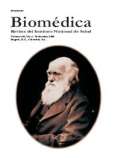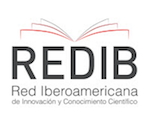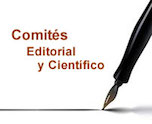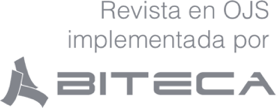Tipología de los consumidores de alcohol y sus factores determinantes en Bucaramanga, Colombia
Palabras clave:
alcoholismo/epidemiología, consumo de bebidas alcohólicas, diagnóstico, salud pública, Colombia.
Resumen
Introducción. En Colombia algunas consecuencias del consumo de alcohol son problemas de salud pública. Es necesario clasificar adecuadamente a los consumidores para diseñar estrategias de mitigación y control.Objetivo. Establecer los tipos de consumidores de alcohol y sus variables asociadas.
Material y métodos. Se clasificaron 1.199 sujetos entre 18 y 60 años en tres tipos de consumo de alcohol: tipo A, consumo deseable; tipo B, consumo excesivo sin problemas relacionados; y tipo C, consumo problemático o dependencia. Mediante regresión logística multinomial, se establecieron las variables asociadas a los diferentes tipos. Se discute sobre la implicación de los resultados.
Resultados. Los sujetos con expectativas positivas hacia el consumo ligadas con la expresividad y la sexualidad tienen 1,6 (IC95%: 1,0 a 2,5) más veces probabilidad de ser tipo C que aquéllos que sin ellas; en relación con la desinhibición y los sentimientos de poder positivos, este riesgo es mayor, de 2,2 (IC95%: 1,1 a 4,3). La edad, en una relación inversa, es factor protector para ser consumidor tipo B o C. Los hombres tienen mayor riesgo que las mujeres de tipo B o C, al igual que los sujetos que manifestaron gusto moderado o elevado por las bebidas alcohólicas.
Conclusiones. Los resultados deben traducirse en intervenciones en la población, en grupos de riesgo como los escolares y preadolescentes con enfoque de género. El elemento por consolidar en la intervención es el de la autoestima.
Descargas
Los datos de descargas todavía no están disponibles.
Referencias bibliográficas
1. Miller TR, Levy DT, Spicer RS, Taylor DM. Societal costs of underage drinking. J Stud Alcohol. 2006;67: 519-28.
2. Konnopka A, König HH. Direct and indirect costs attributable to alcohol consumption in Germany. Pharmacoeconomics. 2007;25:605-18.
3. Stranges S, Wu T, Dorn JM, Freudenheim JL, Muti P, Farinaro E, et al. Relationship of alcohol drinking pattern to risk of hypertension a population-based study. Hypertension. 2004;44:813-9.
4. Uekermann J, Daum I. Social cognition in alcoholism: a link to prefrontal cortex dysfunction? Addiction. 2008;103:726-35.
5. Room R, Mäkelä K. Typologies of the cultural position of drinking. J Stud Alcohol. 2000;61:475-83.
6. Lesch OM, Kefer J, Lentner S, Mader R, Marx B, Musalek M, et al. Diagnosis of chronic alcoholism-classificatory problems. Psychopathology. 1990;23:88-96.
7. Dobson R. Government must get tough on alcohol misuse, public health experts warn. BMJ. 2008;336:1266-7.
8. Herrán OF, Ardila MF. Consumo de alcohol, riesgo de alcoholismo y alcoholismo en Bucaramanga, Colombia, 2002-2003. Colombia Med. 2005;36:158-67.
9. Herrán OF, Ardila MF. Validity and reproducibility of two semi-quantitative alcohol frequency questionnaires for Colombian population. Public Health Nutr. 2006;9:763-70.
10. Herrán OF, Ardila MF. Validez interna y reproducibilidad de la prueba CAGE en Bucaramanga, Colombia. Biomédica. 2005;25:231-41.
11. Herrán OF, Ardila MF, Barba DM. Consumo problemático de alcohol en Bucaramanga, Colombia: diseño y validación de una prueba. Biomédica. 2008;28:25-37.
12. Brown SA, Goldman MS, Inn A, Anderson LR. Expections of reinforcement from alcohol their domain and relation to drinking patterns. J Consult Clin Psychol. 1980;48:419-26.
13. Goldman MS, Del Boca FK, Darles J. Alcohol expectancy theory: The application of cognitive neuroscience. En: Leonard KE, Blane HT, editors. Psychological theories of drinking and alcoholism. Second edition. New York: Guilford Press; 1999. p. 203-46.
14. Ardila MF, Herrán OF. Expectativas en el consumo de alcohol en Bucaramanga, Colombia. Rev Med Chil. 2008;136:73-82.
15. Penick EC, Powell BJ, Nickel EJ, Read MR, Gabrielli WF, Liskow BI. Examination of Cloninger’s type I and type II alcoholism with a sample of men alcoholics in treatment. Alcohol Clin Exp Res. 1990;14:623-9.
16. Farren CK, Dinan TG. Alcoholism and typology: findings in an Irish private hospital population. J Stud Alcohol. 1996;57:249-52.
17. Colder CR, Chassin L. The psychosocial characteristics of alcohol users versus problem users: data from a study of adolescents at risk. Dev Psychopathol. 1999;11:321-48.
18. Arif AA, Rohrer JE. Patterns of alcohol drinking and its association with obesity: data from the Third National Health and Nutrition Examination Survey, 1988-1994. BMC Public Health. 2005;5:126.
19. Rouillier P, Boutron-Ruault MC, Bertrais S, Arnault N, Daudin JJ, Bacro JN, et al. Drinking patterns in French adult men-a cluster analysis of alcoholic beverages and relationship with lifestyle. Eur J Nutr. 2004;43:69-76.
20. Carrasco AM. Consumo de alcohol y estilos de vida: una tipología de los adolescentes españoles. Revista de Psicología Social. 2004;19:51-79.
21. Colder CR, Chassin L. The psychosocial characteristics of alcohol users versus problem users: data from a study of adolescents at risk. Dev Psychopathol. 1999;11:321-48.
22. Norman G, Streiner D. Bioestadística. Barcelona: Editorial Mosby; 1996. p. 129-48.
23. Tavella NM. Análisis de los ítems en la construcción de instrumentos psicométricos. México D.F.: Editorial Trillas; 1978. p. 75.
24. Herrán OF, Ardila MF. Validez factorial del cuestionario de expectativas hacia el consumo de alcohol (AEQ-III), en adultos de Bucaramanga, Colombia. Rev Med Chil. 2007;135:488-95.
25. Wall AM, Thrussell C, Lalonde RN. Do alcohol expectancies become intoxicated outcomes? A test of social-learning theory in a naturalistic bar setting. Addictive Behav. 2003;28:1271-83.
26. González J. Alcohol. Tipos de intervención en el consumo de riesgo. Fecha de consulta: 20 de agosto de 2008. Disponible en:http://www.seslap.com/seslap/html/pubBiblio/revista/n_8/n8Art2.pdf
27. Greenland S. Modeling and variable selection in epidemiologic analysis. Am J Public Health. 1989;79:340-9.
28. Hosmer DW, Lemeshow S. Applied logistic regression. Second edition. New York: John Wiley & Sons, Inc.; 2000.
29. Long JS. Regression models for categorical and limited dependent variables. London: SAGE Publications; 1997. p. 148-86.
30. Centro para el Control de las Enfermedades. EpiInfo, versión 6.04d. Epidemiología en ordenadores. Atlanta, Georgia: Centro para el Control de las Enfermedades; 2001.
31. Eltinge JL, Sribney WM. Estimation of means, totals, ratios, and proportions for survey data. Stata Technical Bulletins. 1996;6:213-35.
32. Levy SP, Lemeshow S. Sampling of populations: Methods and applications. Third edition. New York: Jhon Wiley & Sons; 1999. p. 365-90.
33. StataCorp. Stata Statistical Software: Release 10.1 Collegue Station, TX: StataCorp LP; 2008.
34. Goldberg LR. The development of markers for the Big-five factor structure. Psychol Assess. 1992:4;26-42.
35. Sher KJ, Trull TJ, Bartholow BD, Vieth A. Personality and alcoholism: issues, methods, and etiological processes. En: Leonard KE, Blane HT, editors. Psychological theories of drinking and alcoholism. Second edition. New York: Guilford Press; 1999. p. 54-105.
36. Penick EC, Powell BJ, Nickel EJ, Read MR, Gabrielli WF, Liskow BI. Examination of Cloninger’s type I and type II alcoholism with a sample of men alcoholics in treatment. Alcohol Clin Exp Res. 1990;14:623-9.
37. Kilty KM. Drinking styles of adolescents and young adults. J Stud Alcohol. 1990;51:556-64.
38. Fan AZ, Russell M, Stranges S, Dorn J, Trevisan M. Association of lifetime alcohol drinking trajectories with cardiometabolic risk. J Clin Endocrinol Metab. 2008;93:154-61.
39. Pelucchi C, Gallus S, Garavello W, Bosetti C, La Vecchia C. Alcohol and tobacco use, and cancer risk for upper aerodigestive tract and liver. Eur J Cancer Prev. 2008;17:340-4.
40. Mora J, Natera G. Expectativas, consumo de alcohol y problemas asociados en estudiantes universitarios de la ciudad de México. Salud Pública Mex. 2001;43:89-96.
41. Wild LG, Flisher AJ, Bhana A, Lombard C. Associations among adolescent risk behaviours and self-esteem in six domains. J Child Psychol Psychiatry. 2004;45:1454-67.
42. Medina-Mora ME, Borges G, Villatoro J. The measurement of drinking patterns and consequences in Mexico. J Subst Abuse. 2000;12:183-96.
43. Wild LG, Flisher AJ, Bhana A, Lombard C. Substance abuse, suicidality, and self-esteem in South African adolescents. J Drug Educ. 2004;34:1-17.
2. Konnopka A, König HH. Direct and indirect costs attributable to alcohol consumption in Germany. Pharmacoeconomics. 2007;25:605-18.
3. Stranges S, Wu T, Dorn JM, Freudenheim JL, Muti P, Farinaro E, et al. Relationship of alcohol drinking pattern to risk of hypertension a population-based study. Hypertension. 2004;44:813-9.
4. Uekermann J, Daum I. Social cognition in alcoholism: a link to prefrontal cortex dysfunction? Addiction. 2008;103:726-35.
5. Room R, Mäkelä K. Typologies of the cultural position of drinking. J Stud Alcohol. 2000;61:475-83.
6. Lesch OM, Kefer J, Lentner S, Mader R, Marx B, Musalek M, et al. Diagnosis of chronic alcoholism-classificatory problems. Psychopathology. 1990;23:88-96.
7. Dobson R. Government must get tough on alcohol misuse, public health experts warn. BMJ. 2008;336:1266-7.
8. Herrán OF, Ardila MF. Consumo de alcohol, riesgo de alcoholismo y alcoholismo en Bucaramanga, Colombia, 2002-2003. Colombia Med. 2005;36:158-67.
9. Herrán OF, Ardila MF. Validity and reproducibility of two semi-quantitative alcohol frequency questionnaires for Colombian population. Public Health Nutr. 2006;9:763-70.
10. Herrán OF, Ardila MF. Validez interna y reproducibilidad de la prueba CAGE en Bucaramanga, Colombia. Biomédica. 2005;25:231-41.
11. Herrán OF, Ardila MF, Barba DM. Consumo problemático de alcohol en Bucaramanga, Colombia: diseño y validación de una prueba. Biomédica. 2008;28:25-37.
12. Brown SA, Goldman MS, Inn A, Anderson LR. Expections of reinforcement from alcohol their domain and relation to drinking patterns. J Consult Clin Psychol. 1980;48:419-26.
13. Goldman MS, Del Boca FK, Darles J. Alcohol expectancy theory: The application of cognitive neuroscience. En: Leonard KE, Blane HT, editors. Psychological theories of drinking and alcoholism. Second edition. New York: Guilford Press; 1999. p. 203-46.
14. Ardila MF, Herrán OF. Expectativas en el consumo de alcohol en Bucaramanga, Colombia. Rev Med Chil. 2008;136:73-82.
15. Penick EC, Powell BJ, Nickel EJ, Read MR, Gabrielli WF, Liskow BI. Examination of Cloninger’s type I and type II alcoholism with a sample of men alcoholics in treatment. Alcohol Clin Exp Res. 1990;14:623-9.
16. Farren CK, Dinan TG. Alcoholism and typology: findings in an Irish private hospital population. J Stud Alcohol. 1996;57:249-52.
17. Colder CR, Chassin L. The psychosocial characteristics of alcohol users versus problem users: data from a study of adolescents at risk. Dev Psychopathol. 1999;11:321-48.
18. Arif AA, Rohrer JE. Patterns of alcohol drinking and its association with obesity: data from the Third National Health and Nutrition Examination Survey, 1988-1994. BMC Public Health. 2005;5:126.
19. Rouillier P, Boutron-Ruault MC, Bertrais S, Arnault N, Daudin JJ, Bacro JN, et al. Drinking patterns in French adult men-a cluster analysis of alcoholic beverages and relationship with lifestyle. Eur J Nutr. 2004;43:69-76.
20. Carrasco AM. Consumo de alcohol y estilos de vida: una tipología de los adolescentes españoles. Revista de Psicología Social. 2004;19:51-79.
21. Colder CR, Chassin L. The psychosocial characteristics of alcohol users versus problem users: data from a study of adolescents at risk. Dev Psychopathol. 1999;11:321-48.
22. Norman G, Streiner D. Bioestadística. Barcelona: Editorial Mosby; 1996. p. 129-48.
23. Tavella NM. Análisis de los ítems en la construcción de instrumentos psicométricos. México D.F.: Editorial Trillas; 1978. p. 75.
24. Herrán OF, Ardila MF. Validez factorial del cuestionario de expectativas hacia el consumo de alcohol (AEQ-III), en adultos de Bucaramanga, Colombia. Rev Med Chil. 2007;135:488-95.
25. Wall AM, Thrussell C, Lalonde RN. Do alcohol expectancies become intoxicated outcomes? A test of social-learning theory in a naturalistic bar setting. Addictive Behav. 2003;28:1271-83.
26. González J. Alcohol. Tipos de intervención en el consumo de riesgo. Fecha de consulta: 20 de agosto de 2008. Disponible en:http://www.seslap.com/seslap/html/pubBiblio/revista/n_8/n8Art2.pdf
27. Greenland S. Modeling and variable selection in epidemiologic analysis. Am J Public Health. 1989;79:340-9.
28. Hosmer DW, Lemeshow S. Applied logistic regression. Second edition. New York: John Wiley & Sons, Inc.; 2000.
29. Long JS. Regression models for categorical and limited dependent variables. London: SAGE Publications; 1997. p. 148-86.
30. Centro para el Control de las Enfermedades. EpiInfo, versión 6.04d. Epidemiología en ordenadores. Atlanta, Georgia: Centro para el Control de las Enfermedades; 2001.
31. Eltinge JL, Sribney WM. Estimation of means, totals, ratios, and proportions for survey data. Stata Technical Bulletins. 1996;6:213-35.
32. Levy SP, Lemeshow S. Sampling of populations: Methods and applications. Third edition. New York: Jhon Wiley & Sons; 1999. p. 365-90.
33. StataCorp. Stata Statistical Software: Release 10.1 Collegue Station, TX: StataCorp LP; 2008.
34. Goldberg LR. The development of markers for the Big-five factor structure. Psychol Assess. 1992:4;26-42.
35. Sher KJ, Trull TJ, Bartholow BD, Vieth A. Personality and alcoholism: issues, methods, and etiological processes. En: Leonard KE, Blane HT, editors. Psychological theories of drinking and alcoholism. Second edition. New York: Guilford Press; 1999. p. 54-105.
36. Penick EC, Powell BJ, Nickel EJ, Read MR, Gabrielli WF, Liskow BI. Examination of Cloninger’s type I and type II alcoholism with a sample of men alcoholics in treatment. Alcohol Clin Exp Res. 1990;14:623-9.
37. Kilty KM. Drinking styles of adolescents and young adults. J Stud Alcohol. 1990;51:556-64.
38. Fan AZ, Russell M, Stranges S, Dorn J, Trevisan M. Association of lifetime alcohol drinking trajectories with cardiometabolic risk. J Clin Endocrinol Metab. 2008;93:154-61.
39. Pelucchi C, Gallus S, Garavello W, Bosetti C, La Vecchia C. Alcohol and tobacco use, and cancer risk for upper aerodigestive tract and liver. Eur J Cancer Prev. 2008;17:340-4.
40. Mora J, Natera G. Expectativas, consumo de alcohol y problemas asociados en estudiantes universitarios de la ciudad de México. Salud Pública Mex. 2001;43:89-96.
41. Wild LG, Flisher AJ, Bhana A, Lombard C. Associations among adolescent risk behaviours and self-esteem in six domains. J Child Psychol Psychiatry. 2004;45:1454-67.
42. Medina-Mora ME, Borges G, Villatoro J. The measurement of drinking patterns and consequences in Mexico. J Subst Abuse. 2000;12:183-96.
43. Wild LG, Flisher AJ, Bhana A, Lombard C. Substance abuse, suicidality, and self-esteem in South African adolescents. J Drug Educ. 2004;34:1-17.
Cómo citar
1.
Herrán OF, Ardila MF. Tipología de los consumidores de alcohol y sus factores determinantes en Bucaramanga, Colombia. Biomed. [Internet]. 1 de diciembre de 2009 [citado 26 de julio de 2024];29(4):635-46. Disponible en: https://revistabiomedica.org/index.php/biomedica/article/view/141
Algunos artículos similares:
- Constanza Pardo, Ricardo Cendales, Supervivencia de pacientes con cáncer de cuello uterino tratadas en el Instituto Nacional de Cancerología , Biomédica: Vol. 29 Núm. 3 (2009)
- Concepción Judith Puerta, Paula Ximena Pavia, Marleny Montilla, Carolina Flórez, Giomar Herrera, Juan Manuel Ospina, Fred Manrique, Rubén Santiago Nicholls, Reporte del primer caso de enfermedad de Chagas transplacentaria analizado por AP-PCR en Moniquirá, Boyacá , Biomédica: Vol. 29 Núm. 4 (2009)
- Yolanda Lucía López, Claudia González, Berta Natalia Gallego, Ana Lida Moreno, Rectoría de la vigilancia en salud pública en el sistema de seguridad social en salud de Colombia: estudio de casos , Biomédica: Vol. 29 Núm. 4 (2009)
- Berta Nelly Restrepo, Margarita Arboleda, Ruth Ramírez, Gonzalo Álvarez, Actividad sérica de la acetilhidrolasa del factor activador de plaquetas en pacientes afrodescendientes y mestizos con dengue, Colombia , Biomédica: Vol. 31 Núm. 4 (2011)
- Sandy Milena Caldera, María Cristina Jaramillo, Suljey Cochero, Alveiro Pérez-Doria, Eduar Elías Bejarano, Diferencias genéticas entre poblaciones de Aedes aegypti de municipios del norte de Colombia, con baja y alta incidencia de dengue , Biomédica: Vol. 33 (2013): Suplemento 1, Fiebres hemorrágicas
- Mabel Carabalí, Clara Beatriz Ocampo, María Eugenia Toledo, Lyda Osorio, Difusión masiva de reportes situacionales sobre dengue: efectos de la intervención en Guadalajara de Buga, Colombia , Biomédica: Vol. 33 (2013): Suplemento 1, Fiebres hemorrágicas
- Ricardo Cendales, Constanza Pardo, Claudia Uribe, Guillermo López, María Clara Yépez, Luis Eduardo Bravo, Calidad de los datos en los registros de cáncer de base de población en Colombia , Biomédica: Vol. 32 Núm. 4 (2012)
- Sara E. Del Castillo, Gonzalo A. Patiño, Oscar F. Herrán, Inseguridad alimentaria: variables asociadas y elementos para la política social , Biomédica: Vol. 32 Núm. 4 (2012)
- Javier H. Eslava-Schmalbach, Carlos Javier Rincón, Carol Cristina Guarnizo, ‘Inequidad’ de la expectativa de vida al nacer por sexo y ‘departamentos’ de Colombia , Biomédica: Vol. 33 Núm. 3 (2013)
- Álvaro A. Faccini-Martínez, Hugo A. Sotomayor, Reseña histórica de la peste en Suramérica: una enfermedad poco conocida en Colombia , Biomédica: Vol. 33 Núm. 1 (2013)
Publicado
2009-12-01
Número
Sección
Artículos originales
| Estadísticas de artículo | |
|---|---|
| Vistas de resúmenes | |
| Vistas de PDF | |
| Descargas de PDF | |
| Vistas de HTML | |
| Otras vistas | |


























